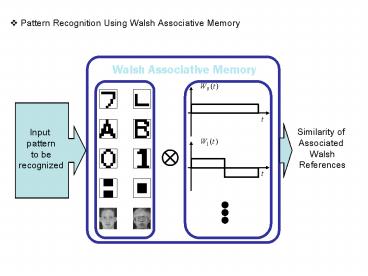Pattern Recognition Using Walsh Associative Memory PowerPoint PPT Presentation
1 / 9
Title: Pattern Recognition Using Walsh Associative Memory
1
- Pattern Recognition Using Walsh Associative
Memory
Walsh Associative Memory
Input pattern to be recognized
Similarity of Associated Walsh References
2
- Finding Optimal Pattern-Walsh Association for
Walsh Associative Memory
The better Walsh sequence is associated, the more
recognition performance improvement (the more
crosstalk reduction) for Walsh-based distributed
associative memory is acquired.
Walsh Spectrum Based Association GA based Optimal
Association
3
- Horizontal and Hierarchical Structure for
Multiple Walsh Associative Memory
Speed Performance
Capacity Performance
4
- Finding Optimal Memory Allocation for Horizontal
Multiple Associative Memory
Database
Database
Memory 1
Memory 2
Memory 3
Memory n
Memory 1
Memory 2
Memory 3
Memory m
n ? m
5
- Memory Management Model using Walsh Associative
Memory
Time elapses
Short-term Memory
Memory Forgetting
Pattern Index of Memory
Input Pattern
Indicate at which memory each pattern is stored
Recognition of Input Pattern
Strength of each pattern of saving
Potentiation From Short-term Memory to Long-term
Memory
Memory Update
6
Property of Walsh Memory
- Memory Forgetting
Interference Theory (John McGeoch, 1932) - Memory
forgets stored information by overlapping many
patterns - Need not make any operation for memory
forgetting
Decay Theory (Peterson and Peterson, 1962) -
Memory forgets stored information as time
elapse - Use Decaying factor lt 1
Multiply Memory by decaying factor each time step
Use context based retrieval
Forgetting as Discrimination (Capaldi and Neath,
1995) - Information does not stand alone, but
stands with contextual cues - There is no memory
loss. Just cant retrieve with insufficient cues
7
- Recognition of Input Pattern
Input Pattern
W
Take the index Which has maximum Walsh Spectrum
- Short-term to Long-term
Normalized maximum Walsh Spectrum gt threshold ?
long-term
8
- Memory Update
Store the pattern existing Memory Without
recognition error For the all the stored patterns
Is the pattern new?
yes
no
Did an error occur?
Store the pattern In the Memory which stores the
pattern And increase strength by 1
yes
Use additional memory space
9
- Demo System using Walsh Associative Memory
Face Based Human Identification and Emotion
Recognition System
Identification
Face Recognition using Walsh Associative Memory
Other Human Identification Method (Password,
Voice, Fingerprint, )
Face tracking
AAM, Mean Shift
Emotion Recognition (Understanding)
Emotion Memory for Person A
Emotion Memory for Person B

